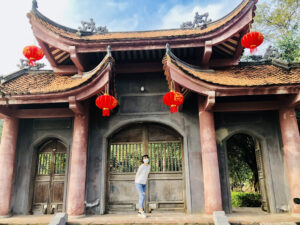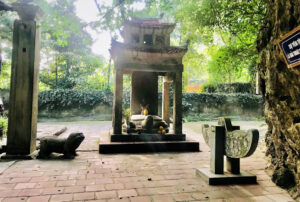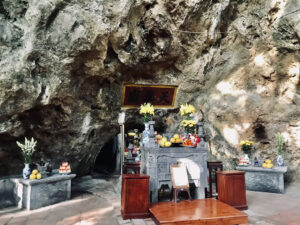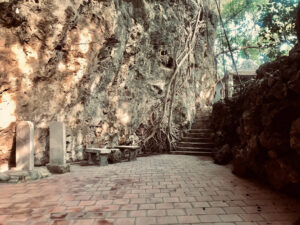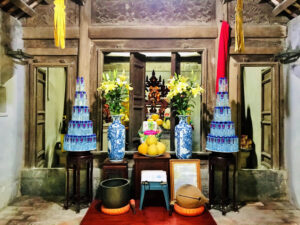While in Hoa Lu Ancient Capital, a “don’t miss” place to visit is the Thiên Tôn Cave/Pagoda . Believed to be one of the oldest temples in Vietnam, the pagoda is a place of worship for the Daoist God/Saint Thien Ton. As a sacred and revered figure in the spiritual life of the local people, Thien Ton is considered one of the four gods who guard the ancient capital of Hoa Lu.
The pagoda and cave are in the Dũng Đương mountains, whose name means “the mountain that blocks the strong water flowing from above”. Indeed, as an imposing natural bulwark to early southern Chinese invasions, it seems the a particularly apt metaphor.
As the Pagoda/Cave guards the ancient natural barrier from incursions from the East, Thien Ton is one of the four major “gateways” to the ancient city of Hoa Lu. ( Nho Quan is the western gateway, Tràng An to the south, and Gia Vien the all-important gateway to the north)
Entering the Temple
The unique beauty of Thien Ton begins at the entrance. Like many pagodas and temples of the period there are the three arches of Vietnamese Buddhism. However, here they are made from wood, not stone. Painted red with curved roof tiles and hanging lanterns they give an almost festive feel to the place. Over the years Thien Ton Pagoda has been added to, repaired and renovated extensively. That said, the temple still retains some of its original artifacts such as the cave itself, the stele house and the stone lions of the Ly dynasty (1009-1225).
Thiên Tôn Cave-Pagoda is also a place for homage to the nature deities of Vietnamese folk religion and ancestral worship of the generations of monks who previously managed the pagoda. The extensive grounds are surrounded by an expansive garden area planted with many fruit trees and ancient trees that celebrate new life, good luck and prosperity. Unusually, the garden also incorporates a variety of vegetables and table foods. The Vietnamese are a practical people and perhaps the early designers thought to create a fresh atmosphere and a showcase for the richness of the area.
A Place of Peace
In late afternoon, the wind combines with the smoke of incense and blows through the wind chimes left hanging on ancient Longan trees. The cool winds and the tinkle of bells brings a sense of peaceful tranquility that removes the cares of day to day life. Sunlight breaking through the canopy of tall trees mixes with the sound of birds singing and the heady scent of flowers in bloom does what its creators intended, emphasizing the poetic and relaxing the mind.
Even without an interest or knowledge of the historical significance of the place, Thien Ton Pagoda is a beautiful and calming temple to visit.
Inside the pagoda’s main areas are 18 Arhats (statues of revered disciples) mounted against the living rock. There are numerous carving of dragons adoring the moon, Phoenix rising, flowers and motifs from the three major religions of Vietnam – Confucius, Tao/Dao and Buddha. Suspended above all this is a large bronze temple bell from the 1700’s, with four protuberances at the sides that each ring with a different sound, depending on where it is struck.
Gods and Myths
Behind the altar is a statue of Thiên Tôn (aka Chân Vũ Đế Quân aka Xuanwu), depicted as a god of Daoism, holding a sword while standing on a Tortoise’s back. Legend says that evil spirits and bad luck once harassed the local population. The Jade Emperor (Supreme Lord) of Dao arranged for Thien Ton to reincarnate as a human to defeat the monsters and thieves.
However fanciful this sounds, remember in Greece and other great civilizations the intertwining of the gods and mortals is also strong in ancient myth. Vietnam is no different, with religion and war craft often intertwined and seen as necessary attributes for a truly powerful spiritual leader.
Another legend about Thien Ton cave has the young Đinh Bộ Lĩnh entering the Taoist grotto to pray for success in his long campaign to unify the 12 feudal warlords of ancient Vietnam. Thien Ton’s “Turtle and Snake generals” gave him their blessings, and in 968 he successfully united the twelve warlords to found the Dinh Dynasty (968-980). This was the first time in a millennia the people of Hoa Lu/Văn Lang became an independent state, the Đại Cồ Việt nation.
Practical Gods
With a mountainous terrain surrounded by fast flowing rivers, Thien Ton was a natural stronghold. The pragmatic new King remembered his debt and built the first Thien Ton pagoda in tribute to his success. With typical Vietnamese pragmatism, it also was a place to welcome the envoys of the warlords and the Song dynasty for diplomatic receptions. The king also built a watchtower here to observe the various comings and goings and as a physical expression of the new kingdom’s strength.
Further past the statue Thien Ton there is a small passage into a second, smaller grotto. Here is an altar with a statue of the Mother Goddess of Vietnamese folk religion, wearing white clothes aside an underground water pond.
A Buddhist Nativity
To right of the god Thien Ton altar is a short corridor leading up to the original ancient pagoda where the diversity of Vietnam religious beliefs are more than apparent. In the center is a statue of the Sakyamuni (Infant Buddha), surrounded by nine mythical dragons while below are the natural spirits and gods of the ancient religions congratulating him on his birth.
Sculptures of the Three Pure Ones (aka Three Pure Pellucid Ones), the greatest gods and the pure embodiment of the Tao and the genesis of all sentient creatures, rise above this nativity scene. On the left of these is a statue of the Guan Yin aka Avalokiteśvara Bodhisattva, with figurines of Guan Yin’s parents to the right.
This ancient place was originally a Taoist grotto, constructed by the notorious governor Lord Cao Biền aka Gao Pian ( 821-887) of the Tang – Chinese dynasty.In Vietnamese folk oral tradition, people consider Cao Bien a warlock, gifted in the feng shui and fortune-telling of Taoism but hardened against the local people. On his first visit to Thien Ton he saw the ”dragon vein of Feng Shui” in Hao Lu was extremely abundant.
He believed the temple was capable of giving birth to Vietnamese leaders and artisans and, being a vindictive man, he put a curse on the land. The story continues that his magic failed against such a natural powerful place, so he made the grotto to keep his own magic strong. Fortunately, Thien Ton preferred the local populace to the Chinese invaders and Vietnamese society survived the evil warlord.
Legends
There are many legends and myths in Vietnam, some more embellished than others and sometimes conflicting. However there has never been any doubt that Thien Ton Pagoda is indeed a special place that played an pivotal role in the development of Dai Co Viet, the precursor of modern Vietnam.
Over the centuries Thien Ton pagoda has undergone multiple renovations and refurbishments . The most recent was in 1936 but the various rebuilds and reconstructions date back to the 10th century when King Dinh extended the original Taoist site. Throughout it all, the old pagoda has retained its inviting spirituality and ancient classical aspect.
Entry and parking at the pagoda is free. During Tet and other festivals, many visitors make an annual pilgrimage to Thien Ton to pray for good luck and prosperity. At these times,parking may incur a charge. While visitors enter for free, this site encourages them to use the donation boxes to help maintain this hallowed place and perhaps to pray for future luck and peace.

